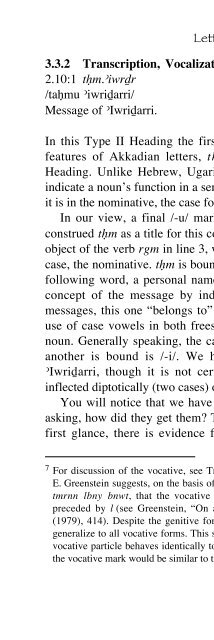A Primer on Ugaritic: Language, Culture, and Literature - enenuru
A Primer on Ugaritic: Language, Culture, and Literature - enenuru
A Primer on Ugaritic: Language, Culture, and Literature - enenuru
Create successful ePaper yourself
Turn your PDF publications into a flip-book with our unique Google optimized e-Paper software.
Letters 47<br />
3.3.2 Transcripti<strong>on</strong>, Vocalizati<strong>on</strong>, <strong>and</strong> Notes (KTU 2.10)<br />
2.10:1 thm.}iwrdr<br />
/tahmu }iwridarri/<br />
Message of }Iwridarri.<br />
In this Type II Heading the first word, <strong>on</strong> the basis of parallel<br />
features of Akkadian letters, thm, is a noun <strong>and</strong> part of the<br />
Heading. Unlike Hebrew, <strong>Ugaritic</strong> used case ending vowels to<br />
indicate a noun’s functi<strong>on</strong> in a sentence. Since thm is part of a title,<br />
it is in the nominative, the case for subjects, vocatives, <strong>and</strong> titles. 7<br />
In our view, a final /-u/ marks this vocative. Since we have<br />
c<strong>on</strong>strued thm as a title for this communiqué, <strong>and</strong> not as the direct<br />
object of the verb rgm in line 3, we have indicated the appropriate<br />
case, the nominative. thm is bound to, or in close relati<strong>on</strong>ship to, a<br />
following word, a pers<strong>on</strong>al name. This pers<strong>on</strong>al name limits the<br />
c<strong>on</strong>cept of the message by indicating that of all the possible<br />
messages, this <strong>on</strong>e “bel<strong>on</strong>gs to” }Iwridarri. <strong>Ugaritic</strong> retained the<br />
use of case vowels in both freest<strong>and</strong>ing <strong>and</strong> bound forms of the<br />
noun. Generally speaking, the case vowel for the noun to which<br />
another is bound is /-i/. We have indicated this <strong>on</strong> the PN,<br />
}Iwridarri, though it is not certain that PNs were c<strong>on</strong>sistently<br />
inflected diptotically (two cases) or triptotically (three cases).<br />
You will notice that we have supplied “vowels.” You may be<br />
asking, how did they get them? Though it may not be apparent at<br />
first glance, there is evidence for rec<strong>on</strong>structing the vowels in<br />
7 For discussi<strong>on</strong> of the vocative, see Tropper, Ugaritische Grammatik, §54.2.<br />
E. Greenstein suggests, <strong>on</strong> the basis of KTU 1.17, I 23–24, ltbrknn ltr ilaby //<br />
tmrnn lbny bnwt, that the vocative takes the genitive case, at least when<br />
preceded by l (see Greenstein, “On a New Grammar of <strong>Ugaritic</strong>,” IOS 18<br />
(1979), 414). Despite the genitive form aby, itisnot certain that <strong>on</strong>e should<br />
generalize to all vocative forms. This suggesti<strong>on</strong> also seems to assume that the<br />
vocative particle behaves identically to the prepositi<strong>on</strong> l-. Itseems, rather, that<br />
the vocative mark would be similar to the Akkadian luœ.


